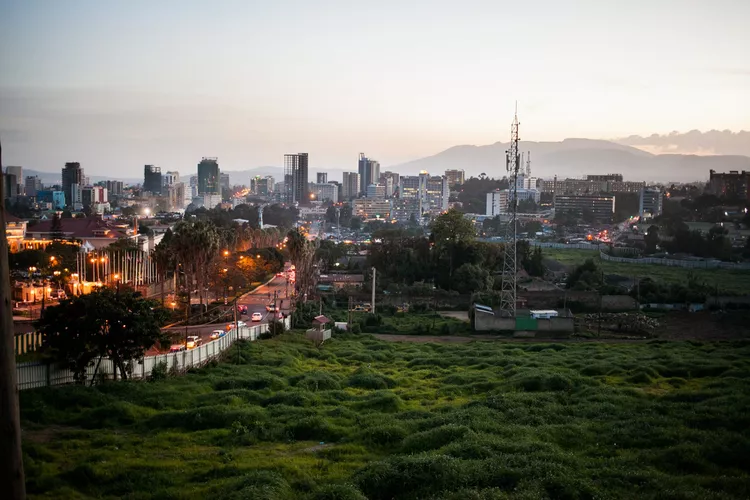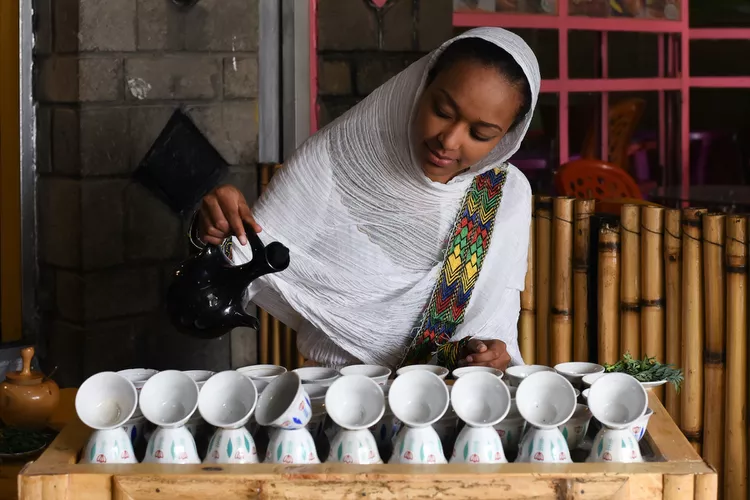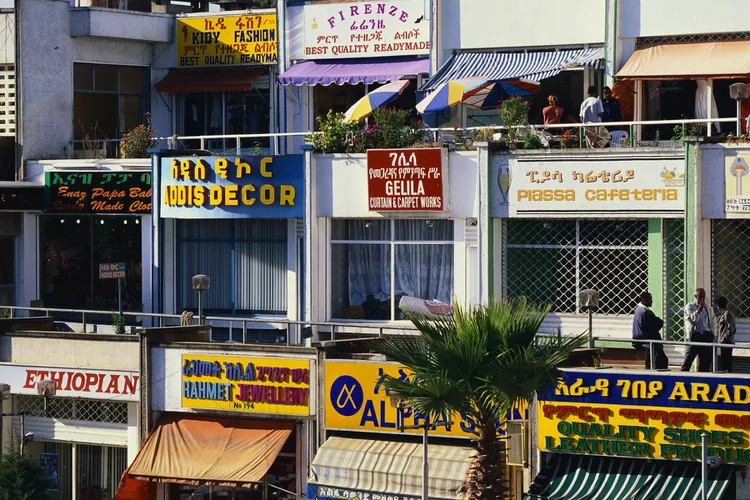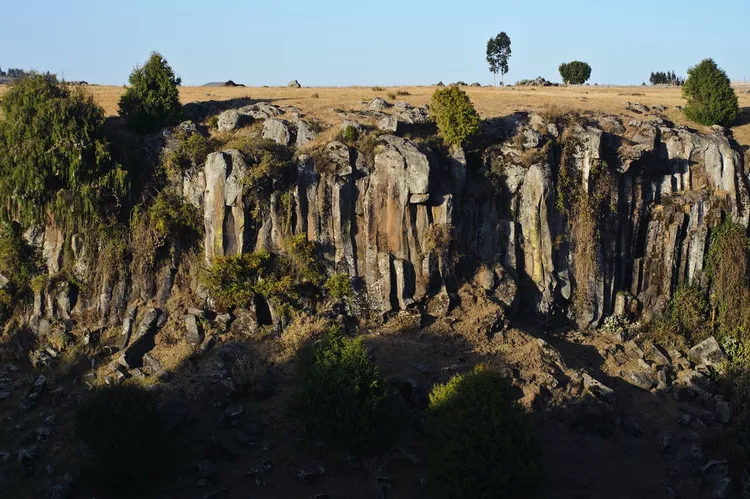My fiancee, Wen, and I flew south from Istanbul in the middle of the night. It was uncertain; during the winter of 2016-17, the sabers rattled in Turkey and Greece, Europe was in turmoil, and you know the rest. The first quarter moon is a blood-red crescent. In the stretch of the uninhabited Sahara desert below us, the end has come early, with no sign of humanity.
Then, an hour after midnight, a soft orange light appeared on the ground, reminding me of the firelight I’d seen in my childhood African villages. The plane slanted over the hills, gray humps like the backs of giant elephants, and the light of Ethiopia’s capital, Addis Ababa, darted toward us.
For two decades, I passed through the city on my way to my parents’ banana farm in Zambia or on missions to countries south of Zambia. I always thought Ethiopia would wait. It has a reputation for being safe, full of ancient culture, and timeless.
Then, as an artist, Win took a tour of the country, painting wind-swept plains, Christian pilgrims in white robes, and Muslim women in bright veils. When he returned to our home in Wyoming, he gave me a watercolor he had painted of the 17th-century church of Debre Berhan Selassie in Gonder, northern Ethiopia. “It’s a beautiful country, rugged and very spiritual,” Wen told me. “You’ll like it.”
Arrival in Ethiopia
At two o’clock in the morning—admittedly an odd time to make a first impression of a place—the streets of Addis Ababa (the name means “new flower” in Amharic) are so quiet they seem enchanted. A few old Fiats roamed the streets, donkeys dozed on the dusty roadside, and cats ran along the shaded walls. Ethiopian jazz crooned from a soft-looking bar. A lone cyclist rattled along the street.
We pulled into the Sheraton Hotel, a stately building near the National Palace. The annual summit of the African Union had just taken place, and every luxurious room had been occupied by an African dignitary. “Do you think there’s a dictator here?” I asked as I warmed up in the private room of our magnificent bed.

Inequality in Africa keeps you up at night: the dazzling wealth of the continent’s new elites, the depressing corruption, the promise to end the seemingly endless wars, the conflicts over power and resources, and the scramble for rare earth minerals. During our visit, drought threatened the Horn of Africa. Aid agencies have called on the West to take notice, but the West has its own crises to consider.
I got up before dawn. My father used to tell me that dawn was the holiest time of the day, the time for monks, soldiers, and poets. He was always up before anyone else on the farm to check the bananas, and he lit his pipe and wore a bush hat over his eyes. He died shortly before we left for Ethiopia, and I have been grieving for him, dawn by dawn. Now, I’m sitting on the balcony overlooking the hotel garden. The call to prayer came from mosques throughout the city. Birds are singing in the sky. Butterflies are foraging among the blue flowers. The dew glistened on the lawn. The holiest time of the day feels blameless and silent.
One day in Addis Ababa
With only one day to go to Addis Ababa, I chose to skip the city’s many museums and historical sites and head straight to Merkato, a vast open-air bazaar. We wound through narrow alleys, perusing stalls with freshly woven grass baskets, leather saddles, turmeric, and dried beans. The air was filled with rolls of frankincense (it is said that the wise men who gave the gift of frankincense to the baby Jesus were Ethiopians). Blacksmiths and metalworkers tinker with knocks, an improvised performance of open-air jazz. The tailors quickly made the robes out of homespun cotton. The chicken in the cage is complaining.
Everything looked so fresh to me. But at the same time, even the most casual exchanges are tinged with ritual. The ubiquitous coffee ritual, for example, has dozens, if not hundreds, of stalls throughout the market. Customers sit in close quarters on small stools as the beans are roasted and ground. They lit the frankincense. Finally, each customer was served three cups of smooth, rich coffee: one for health, one for prosperity, and one for love.
Coffee is thought to have been discovered in Ethiopia in the 11th century. At that time, tea was used to brew tea. Still, its properties as a companion for happy companions have persisted through the years. Here’s another thing about Ethiopia: People here have lived this civilized, elegant, hospitable life forever because they have.

Of all African countries, only Ethiopia has never been colonized. The Italians twice invaded and temporarily ruled, the second time under Mussolini, who looted ancient artifacts. Of course, the British also tried to settle this place, but the Ethiopians always managed to resist. It says something. Having survived the European scramble for Africa, it makes sense.
First, it means that Ethiopia’s cultural and religious heritage has remained intact over the centuries. Eastern Orthodoxy is the dominant religion in Ethiopia, followed by Islam. The first Orthodox church in Ethiopia was built in 333 AD. About 300 years later, Muslims from Mecca came to Ethiopia. Since then, the two faiths have coexisted more or less peacefully. Prayer, devotions, and rituals are still part of everyday life.
That’s not to say the country didn’t have war, famine, or authoritarian leaders. Sometimes, all three came together in the second half of the 20th century. In 1974, a young army lieutenant, Mengistu Haile Mariam, came to power in a Marxist-Leninist uprising that overthrew Ethiopia’s last emperor, Haile Selassie. In the ensuing civil war between Mengistu’s government and the opposition, tens of thousands of Ethiopians died as a result of the violence, and another million died from famine. In 1991, a coalition of rebel groups finally overthrew the so-called “Butcher of Addis Ababa” Mengistu.
Since then, Ethiopia has enjoyed relative political stability and rapid economic growth. However, these gains rarely reach those most in need in a region where “relative” is often the keyword. With a population of over 99 million, Ethiopia is Africa’s second most populous country. Its neighbors are troubled, with chronic ethnic tensions among the Tigray, Amharic, and Oromo communities. Those tensions recently erupted into violence, prompting the government to declare a state of emergency in 2016.

Around the square in central Addis Ababa, Italy’s brief occupation in the mid-1930s and early 1940s is still evident. It is a pleasant and lively place, with elaborate balconies attached to the grand, crumbling buildings that overlook it. After dark, couples sip coffee at small sidewalk cafes, and shoppers hurry home with the day’s fresh produce.
We found a small pink bar just downhill from the Itague Taitu Hotel (Ethiopia’s first hotel, built in 1898). Six customers, mostly long-haul truck drivers, were resting inside. The radio plays local jazz. It was a cozy place with only a single light bulb and a dim light.
“You’re from America?” Do you want to know our secret to survival?” “Asked a man who identified himself as Robert. I’m taking notes.
“In Ethiopia, nearly 50 percent of us are Orthodox, and most of the rest are Muslims; there are more than 80 ethnic groups. We’re all different. We know this, but we will not allow ourselves to be divided and conquered.” Robert took a sip of his beer. A leader can only divide his people if they agree to be divided.”
Robert pointed to my notebook. “Write it down,” he instructed. “Almost anywhere in Ethiopia, on any small road, you will see an Orthodox church on one side and a mosque on the other. We are in each other’s houses and each other’s lives; we work out our problems with our neighbors. We learned this the hard way: inner integrity makes for a strong community; Weakness of the heart leads to civil war.” He waved to the door of the pub. “For more than 20 years, the doors of this place have been Open Day and night, welcoming anyone. Anyone can.” I asked Robert the name of the bar. There was a confused discussion between the boss and her customer. This place has no name. “There is only one love.” Robert finally suggested. “From now on, we’ll call this place the One Love Inn.”
South to the Bell Mountains
After leaving Addis Ababa, we seemed unable to choose which part of Ethiopia to travel to. We found a guide, or more accurately, the guide found us, the way the best guides find us: the perfect person at the perfect time. Eyob Awraris holds degrees in history and English literature; older Rhodes scholars, culture buffs, and professors came to him.
Win had been north and east on his previous trip, so we drove south along the contours of the Rift Valley: an arid landscape lined with lakes with names like mantras – Koca, Zwe, Langano, Sala, Awasa: flat-topped acacia, those stereotypical silhouettes of East African sunsets, shelter herds of goats. The eucalyptus plantation throbbed in the warm wind. Occasionally, a herd of camels came into view.
It is impossible to take in the vast scenery all at once. The sky seemed to close in on us, and the earth was like an enormous upturned clay dish covered with glistening heat and dust, with no horizon in sight. Most of the land is intensively cultivated: cows and donkeys tear at the dry soil; Horses and donkeys drive threshers; Shepherds of cattle, sheep, and goats.
That evening, at the end of a day’s drive, Wen and I emerged from our Spartan room at the Sabana Beach resort on Lake Langano, him with his sketchbook and me with my notes. As Robert of the One Mind Hotel promised – everywhere we went, there was a small Orthodox church on one side of the path and a small mosque on the other. There was always a villager or two with us, offering help, speaking slowly and deliberately as if to someone who had been out in the sun too long without a hat.
The next day, we drove and drove.

Vastness, especially when coupled with heat and dust, has a calming tendency. The miles flew by, but we must have been here before. “Are you sure we’re not going around in circles?” I asked our guide, Eyob, half-jokingly. Then the Bell Mountains suddenly appeared, steep and verdant in a grain landscape of teff and wheat. Washed by cold winds and wrapped in thin clouds, their arrival was surprising and comforting.
Or, how do I put it? Two days of dusty driving was worth it, more than worth it. Walk from Addis Ababa to the vast highlands of Bale, home to the 530,000 acres of Bale Mountains National Park, a UNESCO World Heritage Site on the tentative list since 2008.
We checked into the Bale Mountain Lodge, an eco-hotel next to a clearing in the park’s Harenna Forest. Opened in 2014, the property now offers a welcoming option for travelers who prefer the comfort of hospitality in the accommodation of natural beauty. The room’s hot water bottle on the bed and the crackling wood stove kept out the cold at night. The food was plentiful and delicious. Patient and talented guides are always ready to show guests around. This place is so relaxing; it’s like paying to relive your perfect childhood.
In front of the hut, a wooden bridge crosses a stream. It leads to a meadow where the occasional antelope grazes. Further on are peak spires covered in lichen-covered trees. The landscape seemed seductively eternal, eternally quiet, and a soothing shade of purple and green. “It’s like something Gauguin would draw,” Wen said.
Inspired by this, Wen set off for the nearby village of Lira with an easel and pencil: two small mosques, several cafes, wheat fields, and domed huts with straw roofs built of clay. Men in turbans, women in veils, proud boys and girls in turbans galloped at toothache speed on strong Arab-looking ponies. Occasionally, an overloaded bus clanged past.
As I hike with Eyob in the lichen-covered forest surrounding the lodge, he tells me that Bell Mountain National Park has more endemic mammals – including the Ethiopian Wolf, one of the world’s most endangered canids – than any other area of its size. We get together for a few days and discuss everything—his faith, ambition, and family: My faith, my children, and my father.
One day, Eyob told me the story of his good friend, Biniam Admasu. Biniam Admasu is an Ethiopian conservationist determined to protect this rare environment and wildlife, especially wolves. In March 2015, fires broke out on the mountainside below the Sanetti Plateau, a significant wolf habitat. “If the flames reached the plateau, Biniam knew the wolves and the cubs in the nest would be finished,” Eyob said.
The fire seemed unstoppable. Villagers joined Biniam in the fight, but as the fire spread, everyone ran or jumped to safety, some breaking limbs except for Biniam, who, against all caution, made desperate efforts towards his beloved Wolf pack, a lone figure struggling with flames in hell.
“Biniam once told us that if he had to die to save the wolves, then he was willing to go,” Eyob said. The 33-year-old man died on the mountainside when a sudden shift in the wind blew flames onto him. That same day, satisfied with his sacrifice, the fire went out after burning for over a week. The Ethiopian Wolf, a rare keystone species, has been spared for now.
Gifts from Ethiopia
We had two dreams during our last days in the mountains. The night Eyob told me about Binian’s death, I had a vivid dream in which the three of us—Eyob, Vin, and I—hiked down from the plateau to the place where Binian had died. After breakfast, I told Ayob about the dream. I told Eyob that it was so clear, so firm.
So we decided to hike down from the plateau, just like I had done in my dream. It’s a steep drop, but it’s achievable. After walking for about 20 minutes, we found the place where Biniam is thought to have lost his life. We settled down in the heather. Ayob closes his eyes and prays. I tried to calm my thoughts. We sat quietly on a rock below us.
Suddenly, out of nowhere, a divining vulture flew rapidly towards us, just a few feet from our heads. Then, it caught a strong updraft and flew into the sky. I watched it soar higher and higher at a terrible speed. It became a fragment, then a dot, and then completely disappeared.

Two nights later, Ayob had a dream. Inside, he and I were exchanging gifts. He said his gift to me was a postcard, written in childish handwriting as if his brother had written it. It said, “Thank you for understanding Ethiopia.” But when he was about to open my present, a bird bumped into his window and woke him up.
In an email shortly after we left Ethiopia, Eyob said he now knew what my talent was. “Thank you,” he wrote, “for giving me the courage to go to the place where Biniam lost his life and for praying for him.” That’s all. That’s all I need. What I can’t find the right words to repay Eyob is that I am as grateful to him as he is. Somehow, on that mountain, as the wings of the divining eagle vanished, my grief for my father disappeared.
Perhaps it’s the enduring, unexpected gift of travel to places where the divine is still daily bread, where elegant hospitality still exists. Maybe that’s why we leave the safety of our homes and risk our journey getting lost. No one really knows what the end is and what the beginning is. Most of us are too busy even to try.
